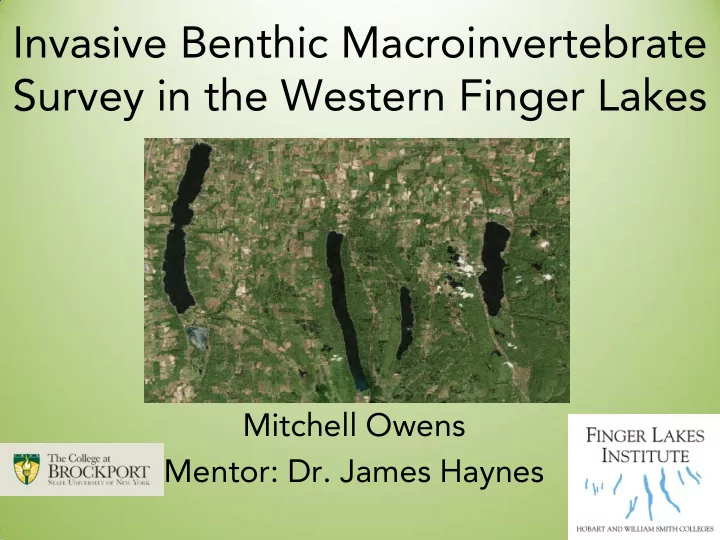

Invasive Benthic Macroinvertebrate Survey in the Western Finger Lakes Mitchell Owens Mentor: Dr. James Haynes
What are Benthic Macroinvertebrates? • Invertebrates living in/on the bottom (benthos) of a lake or pond • Useful in assessing water quality (relatively quick and easy method)
What is an Invasive Species? • Non-native • Reproducing populations • Negatively impacting native communities
The Finger Lakes • 11 lakes located between Rochester and Syracuse, NY • Until 2012, no comprehensive invertebrate studies available for any of the lakes
Goals of the Study • Complete a comprehensive benthic macroinvertebrate survey (including invasive species) of the four western Finger Lakes • Use biotic assessments of water quality to attempt to determine a relationship between watershed land use and water quality
D. polymorpha The Invasive Species Cipangopaludina chinensis Corbicula fluminea Bithinya tentaculata malleata D. bugensis Hemimysis anomala Viviparus georgianus
Corbicula fluminea (Asian Clam) • One of the most common invasives in the world • Presence connected to changes in benthic communities in multiple ways: – Changing benthic structure with its large, rough shell – Affecting how suspended matter is moved from the water column to the benthos • In Keuka, Cayuga, Owasco, and Otisco
Bithinya tentaculata (Faucet Snail) • Long-established invasive from Europe (introduced in late 1800s) • Major concern: intermediate host for numerous trematodes that cause high mortality rates in native waterfowl • In Seneca
Cipangopaludina chinensis malleata (Chinese Mystery Snail) • Recently introduced to Finger Lakes region • Can become very large • Very little known about overall effects on other populations once established • In Canandaigua and Keuka
Viviparus georgianus (Banded Mystery Snail) • From the Mississippi River system, expanded out of its natural range in the 1960s • Again, very little known about its effect on introduced systems • Found in Ontario, Erie, and Canal but not in any Finger Lakes
Dreissena polymorpha and bugensis (Zebra and Quagga mussel) • Most common and most impactful invasive species in Finger Lakes region • Zebra mussels became established first, but is potentially being supplanted by quagga populations • D. polymorpha found in all Finger Lakes • D. bugensis found in all but Owasco and Otisco
Echinogammarus ischnus • 3Presence tied very closely to established Dreissena populations • When established, can displace native arthropods • Found in all Finger Lakes
Hemimysis anomala (Bloody Red Shrimp) • Very new invasive in Finger Lakes region • Also from Ponto-Caspian region • Effects here still unknown, but linked to decreases in native cladoceran & copepod abundances in Europe • Notably, would act as new near- shore predator on zooplankton • Found in Ontario, Erie, and Seneca
Field Methods • 8 sites at each lake chosen based on largest accessible watersheds in each lake • Took a “shallow” and “deep” sample at each site • Used a vacuum suction sampler under a 0.165 m 2 dome
Lab Methods • Samples poured into trays divided into 40 squares and subsampled one square at a time
Invasive Species Occurrences • Only 5 out of 8 potential invasive species found • Only Dreissena mussels found in all 4 lakes • Only Honeoye lake contained all 5 found invasive species B. tentaculata C. c. malleata D. r. bugensis D. polymorpha V. georgianus 1.82 7.46 ± 6.57 9.26 ± 9.10 1.30 ± .004 Conesus Hemlock 17.54 ± 15.62 33.34 ± 26.38 Canadice 14.82 ± 11.78 14.02 ± 18.39 Honeoye 2.98 ± 1.55 0.90 22.77 ± 13.42 14.62 ± 13.61 2.80 ± 1.71
Canandaigua Skaneateles Hemlock Canadice Honeoye Conesus Owasco Cayuga Seneca Keuka Otisco V. georgianus X X C. c. malleata X X X X B. tentaculata X X C. fluminea X X X D. r. bugensis X X X X X X X X X D. polymorpha X X X X X X X X X X X E. ischnus X X X X X X X H. anomala X
Discussion • 3 potential invasive species completely absent – Very difficult to pinpoint reasoning behind their absence though • However, banded mystery snail found for first time in the region
Management Recommendations • Continue all current invasive species prevention measures – Additionally, implement careful, regular monitoring of benthic macroinvertebrate populations and educate stakeholders on recognizing and responding to potential invasive species
Acknowledgements I would like to thank the Finger Lakes Institute and Hillary Mosher for funding this project and going into the field with me to make sure everything went smoothly, Dr. Haynes and the rest of my committee for so much help and guidance putting this project together, Anthony Marsocci for organizing the field crew, Kate Bailey for help with all the critters, and my numerous other field and lab assistants for the help I could not function without.
Questions?
Recommend
More recommend